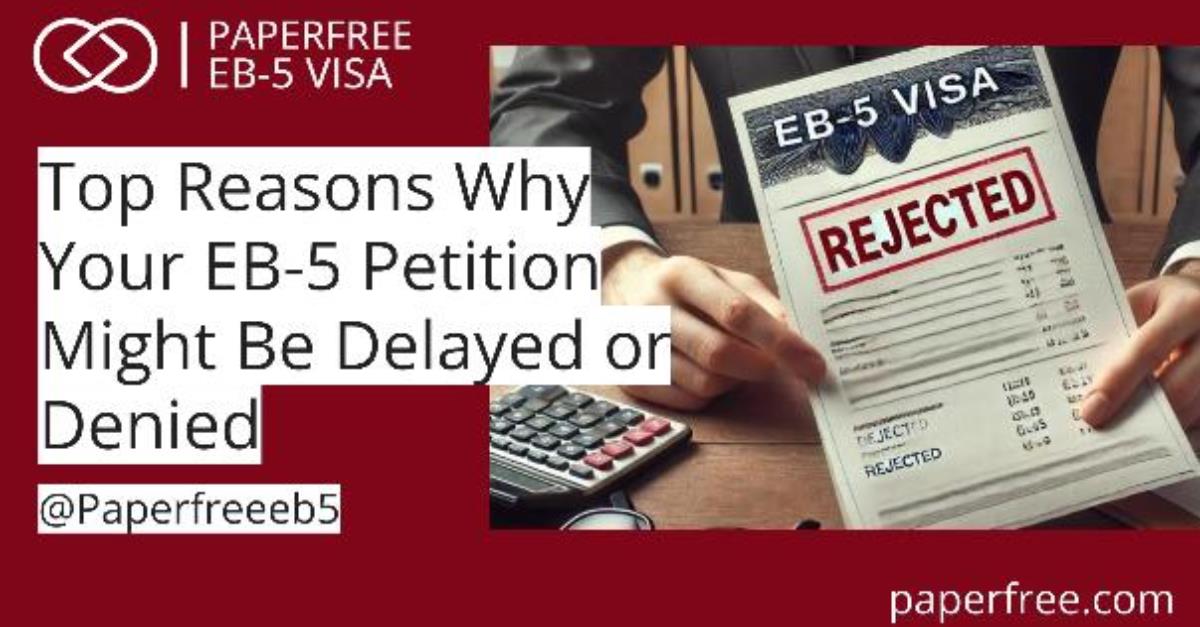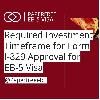Top Reasons Why Your EB-5 Petition Might Be Delayed or Denied
How to Avoid EB 5 Processing Delays and Denials During EB-5 Visa Petition?last updated Friday, April 11, 2025
#eb 5 processing delays #EB-5 visa program
| | by Sidra Jabeen | Content Manager, Paperfree Magazine |

QUICK LINKS
AD
Get Access to EB 5 Visa Investment Projects
The EB-5 Immigrant Investor Program has become an appealing path for foreign nationals to obtain U.S. permanent residency through investment. By contributing to U.S. businesses or real estate projects, investors and their families can secure Green Cards. However, the process is far from straightforward and requires meeting stringent criteria set by the U.S. Citizenship and Immigration Services (USCIS).
Despite its potential benefits, the EB-5 process can often be lengthy and complicated, with many applicants facing delays or even outright denials. Understanding the common reasons why an EB-5 petition may be delayed or denied can significantly improve the chances of a successful petition. This article provides a comprehensive guide on why delays or denials occur, common pitfalls to avoid, and how to navigate the process efficiently.
For more information on potential pitfalls and challenges in obtaining an EB-5 visa, see our detailed article in Paperfree magazine.
Top Reasons Why Your EB-5 Petition Might Be Delayed or Denied: A Comprehensive Guide
1. Failure to Meet the EB-5 Investment Requirement
One of the primary reasons for delays or denials in EB-5 petitions is failing to meet the required investment threshold. To qualify for the EB-5 program, the capital investment must meet specific requirements. Typically, the investment required is $1.8 million. However, if the investment is made in a Targeted Employment Area (TEA)—a region with high unemployment rates—the amount is reduced to $900,000.
Key Pitfalls:
- Insufficient Investment Documentation: If the petition does not clearly demonstrate that the funds were properly invested or do not meet the legal requirements, such as job creation, the petition is likely to be denied.
- Using Borrowed Funds: Borrowed funds can complicate the process unless they are clearly documented and proven to be at risk. The EB-5 program requires that the invested funds be at risk and non-refundable.
- Failure to Show Legal Source of Funds: Investors must clearly document the source of their funds. Failure to provide transparent and thorough documentation can delay or result in denial.
How to Avoid This Issue:
- Ensure that all funds are legally obtained and adequately documented.
- Avoid using borrowed funds, or if using them, demonstrate that they are irrevocably committed to the investment.
2. Inadequate Job Creation Documentation
Job creation is a fundamental requirement for the EB-5 program. The investment must create at least 10 full-time jobs for U.S. workers. Failure to provide adequate documentation that job creation requirements have been met can lead to delays or denials.
Key Pitfalls:
- Insufficient Evidence of Job Creation: Projects must provide strong documentation showing the number of jobs created. This includes business plans, tax filings, payroll records, and employee verification.
- Jobs Not Meeting Requirements: The jobs must be direct, full-time positions. If the project fails to meet this requirement, the petition is at risk of denial.
- Project Changes: Sometimes, projects fail to meet job creation requirements due to changes in the business plan or adverse market conditions, which can delay or impact the approval process.
How to Avoid This Issue:
- Work with your regional center or project to ensure job creation is well-documented and compliant with EB-5 regulations.
- Include all required supporting evidence such as employment records and business plans showing projected job creation.
3. Issues with the Source of Funds
One of the most crucial elements of an EB-5 petition is proving the lawful source of the funds used for the investment. Investors must document how their funds were obtained, whether from personal savings, business income, or other sources. The burden of proof lies entirely with the investor, making it imperative to provide thorough financial records.
Key Pitfalls:
- Unclear or Incomplete Source of Funds Documentation: If the origin of the funds is not well-documented or raises concerns, it can significantly delay the petition process.
- Failure to Disclose Gifts or Loans: Gifts or loans used to fund the investment must be disclosed and documented.
- Funds from Unlawful Sources: Any funds obtained from illicit or illegal sources will lead to immediate denial of the petition.
How to Avoid This Issue:
- Provide a transparent and detailed paper trail showing the lawful origin of the funds.
- Document all gifts, loans, or other financial arrangements used to fund the investment.
4. Inaccurate or Incomplete Petition Documents
The EB-5 application process involves submitting a large volume of paperwork, and even small errors or omissions can cause significant delays. Incomplete forms, missing signatures, or inconsistent information may trigger Requests for Evidence (RFEs) or Notices of Intent to Deny (NOIDs), slowing the process and increasing the chances of denial.
Key Pitfalls:
- Missing or Inaccurate Information: Simple errors, such as missing forms or incorrect data, can cause delays.
- Outdated Documents: Submitting outdated or expired documents can also delay the approval process.
- Inconsistent Information: Discrepancies between different documents can raise red flags and invite additional scrutiny from USCIS.
How to Avoid This Issue:
- Review all documents thoroughly before submission to ensure they are complete and accurate.
- Consult with an immigration lawyer to ensure compliance with all form and document requirements.
5. Changes in the EB-5 Project or Regional Center
If there are significant changes to the EB-5 project or regional center after the petition has been submitted, USCIS may delay processing or deny the petition. Changes in the business model, project location, ownership structure, or other essential aspects can trigger additional scrutiny.
Key Pitfalls:
- Changes to the Project Structure: Changes made to the project or investment structure without prior approval from USCIS may raise concerns.
- Issues with the Regional Center: If the regional center is revoked by USCIS or fails to meet EB-5 requirements, it could directly impact the petition.
How to Avoid This Issue:
- Communicate any changes in the project to USCIS immediately and seek approval if necessary.
- Ensure that the regional center is reputable and in good standing with USCIS.
6. Regional Center Failures or Mismanagement
Investing through a regional center can be advantageous, but it also comes with risks. If the regional center is mismanaged or fails to meet USCIS compliance, the investor’s petition may be delayed or denied.
Key Pitfalls:
- Noncompliance with EB-5 Rules: Regional centers must adhere to specific guidelines related to fund management, job creation, and reporting. Any failure in these areas can impact the investor’s petition.
- Lack of Transparency: Regional centers must maintain transparency in reporting the project’s progress and job creation efforts.
How to Avoid This Issue:
- Thoroughly research the regional center before making an investment.
- Ensure that the regional center has a solid track record of meeting EB-5 requirements.
7. Ineligibility of the Investor
Investors must meet specific eligibility requirements for the EB-5 program. If an investor has a criminal record, prior immigration violations, or does not meet other criteria, their petition may be denied.
Key Pitfalls:
- Prior Immigration Violations: Investors who have overstayed visas or violated U.S. immigration laws may be ineligible for the EB-5 program.
- Criminal History: Certain criminal offenses can prevent an individual from receiving an EB-5 visa.
How to Avoid This Issue:
- Ensure that you meet all eligibility criteria before applying for the EB-5 program.
- Work with an immigration attorney to address any concerns related to past violations or legal issues.
8. Economic Downturn or Project Risk
Economic volatility or setbacks in the project can delay the EB-5 petition process. If the project fails to generate the expected return or create the required jobs, it can affect the petition’s approval.
Key Pitfalls:
- Financial Instability: If the investment project fails to meet EB-5 criteria due to economic conditions, the petition may be rejected.
- Changes in Market Conditions: Economic downturns or adverse conditions affecting real estate or business sectors can hinder the project’s ability to deliver on the job creation promise.
How to Avoid This Issue:
- Invest in projects with solid financial backing and a clear path to success.
- Diversify your investments to mitigate risks associated with economic downturns.
9. Failure to Submit Timely Reports or Updates
Investors are required to provide regular updates to USCIS about the progress of the project and job creation efforts. Failure to submit these updates in a timely manner can cause delays in the petition process.
Key Pitfalls:
- Delayed Reports: Failing to submit progress updates or job creation documentation on time can lead to further scrutiny.
- Incomplete Reports: Reports that lack adequate information or are unclear can delay the processing of the petition.
How to Avoid This Issue:
- Ensure that all periodic updates and reports are submitted on time and are complete.
- Regularly check in with the regional center to ensure that the project is meeting job creation requirements.

Conclusion
The EB-5 Immigrant Investor Program is a powerful tool for securing U.S. permanent residency, but navigating the application process can be challenging. By understanding the common reasons for delays and denials, investors can take proactive steps to improve their chances of success. Ensuring that all documentation is complete, accurate, and compliant with EB-5 requirements is essential. Furthermore, working with experienced legal and financial professionals can help investors avoid pitfalls and streamline the petition process.
Overcome EB-5 Challenges - Get a free online consultation with Paperfree experts today. Start now.
Frequently Asked Questions (FAQs)
1. What are the primary causes of delays in processing EB-5 petitions?
Delays in processing EB-5 petitions are often due to visa availability issues, especially for applicants from high-demand countries. Visa retrogression and waiting for priority dates to become current can contribute to these delays. Monitoring the Visa Bulletin and understanding the priority dates is crucial.
2. Why is documenting the source of funds so crucial for an EB-5 petition?
USCIS requires evidence that the funds used for the EB-5 investment come from legal sources. Without proper documentation, such as financial records, tax returns, and business ownership documents, the petition can be delayed or denied.
3. How can errors in the EB-5 petition affect processing time?
Even minor errors, such as incomplete forms or missing documents, can result in RFEs or NOIDs, which will delay processing. It’s essential to ensure that all documents are correct and complete before submission.
4. What is an RFE in EB-5?
A Request for Evidence (RFE) is issued by USCIS when additional documentation or information is needed to complete the evaluation of an EB-5 petition. RFEs can significantly delay the process, so responding promptly and accurately is critical.
5. What should I do if my EB-5 petition is delayed?
If your petition is delayed, check its status regularly through the USCIS website. If you suspect undue delays, consider filing a writ of mandamus to compel USCIS to adjudicate the petition. Consulting an immigration attorney is essential in these situations.
Pages Related to #eb 5 processing delays
- EB5 Investment Visa Guide 2025

- Paperfree Investment Visa EB-5 Program is Your Your Clear Path to Green Card USA

- US Immigration: Big increase in EB–5 visa fees proposed

- July 2025 Visa Bulletin: EB-5 Investment Visa Program Shows Positive Movement

- EB-5 for Tech Entrepreneurs: Immigration Program for Startup Founders | Paperfree

- EB-5 Investment Protection: How Experienced Developers Safeguard Your Capital | Paperfree

- U.S.-Based EB-5 Investors Surge in 2025 | Concurrent Filing & Loan Repayment Explained

- Investment timeframe for Form I-829 approval for EB5 Visa

Popular Page
Benefits of the EB-5 Visa Program| A Comprehensive Guide
Book a Free Complimentary Call
Search within Paperfree.com
real estate investing Investment Visa USA Investment Magazine Private Real Estate Funds real estate funds
